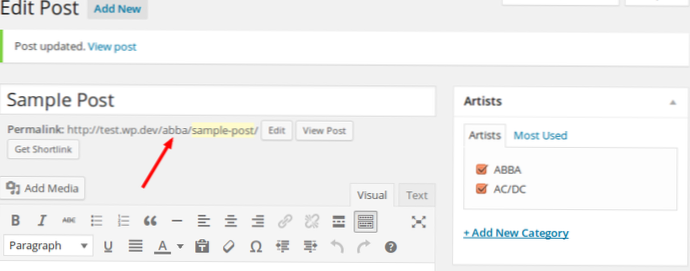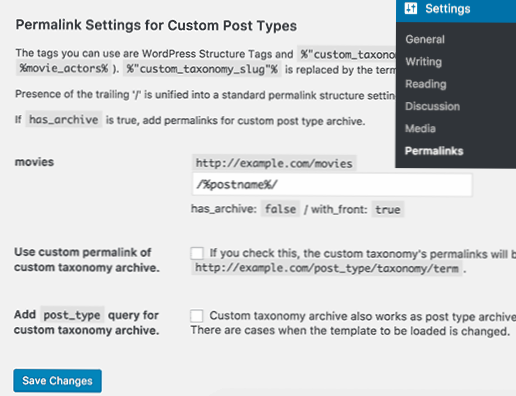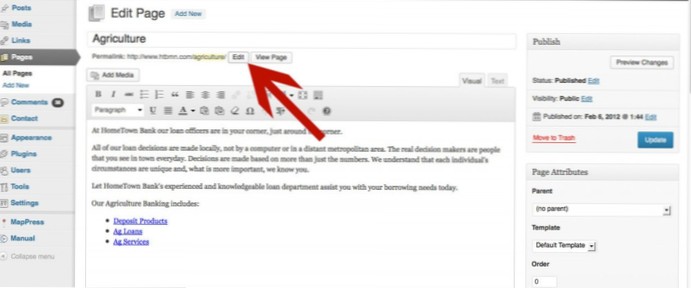- How do you add taxonomies in custom post type?
- How do I create a custom post taxonomy in WordPress?
- How do I change the taxonomy URL in WordPress?
- How do I add a category to a WordPress post URL?
- What is custom post type?
- What are custom fields in WordPress?
- How do I create a custom category?
- Is post type taxonomy?
- How do I create a custom category in WordPress?
- How do I use custom permalinks plugins?
- How do I change the taxonomy slug in WordPress?
- How do I change the custom post type slug in WordPress?
How do you add taxonomies in custom post type?
' So make sure you have a custom post type created before you begin creating your taxonomies. Next, go to CPT UI » Add/Edit Taxonomies menu item in the WordPress admin area to create your first taxonomy. On this screen, you will need to do the following: Create your taxonomy slug (this will go in your URL)
How do I create a custom post taxonomy in WordPress?
In WordPress, you can create (or “register”) a new taxonomy by using the register_taxonomy() function. Each taxonomy option is documented in detail in the WordPress Codex. After adding this to your theme's functions. php file, you should see a new taxonomy under the “Posts” menu in the admin sidebar.
How do I change the taxonomy URL in WordPress?
Changing Custom Post Type Permalinks in WordPress
Upon activation, you need to visit Settings » Permalinks page and scroll down to 'Permalink Settings for Custom Post Types' section. Here you can change the permalink structure of single items in your custom post type.
How do I add a category to a WordPress post URL?
Adding Category and Subcategory in WordPress Post URLs
First, you need to visit Settings » Permalinks page in your WrodPress admin. There you need to click on the 'custom structure' option under common settings area. Next, you need to add /%category%/%postname%/ in the field next to custom structure.
What is custom post type?
A custom post type is nothing more than a regular post with a different post_type value in the database. The post type of regular posts is post , pages use page , attachments use attachment and so on. You can now create your own to indicate the type of content created.
What are custom fields in WordPress?
Custom fields, also referred to as post meta, is a feature in WordPress which allows users to add additional information when writing a post. WordPress stores this information as meta data. Users can display this meta data by using template tags in their WordPress themes.
How do I create a custom category?
Creating a custom category. Use the Policy Management > Filter Components > Edit Categories > Add Category page to add custom categories to any parent category. You can create up to 100 custom categories. Enter a Description for the new category.
Is post type taxonomy?
Post Types is a term used to refer to different types of content in a WordPress site. In all practical sense, it should be called content type. ... WordPress taxonomies are used as a way to group posts and custom post types together. WordPress comes with two default Taxonomies, categories and tags.
How do I create a custom category in WordPress?
Using one is the easiest way to add a custom taxonomy and to get a framework for working with custom content types. If you opt for one of the first two options, rather than a plugin, then you will need to add the code either to your theme's functions. php file or to a custom plugin.
How do I use custom permalinks plugins?
Custom Permalinks is a useful plugin when you need to assign a custom path to individual posts, pages, tags or categories.
...
Custom Permalinks for WordPress
- Login to your WordPress site.
- Go to Plugins > Add new and search for "Custom Permalinks".
- Click "Install Now" and activate the plugin.
How do I change the taxonomy slug in WordPress?
Select functions.
Paste this code at the end of the file. if( 'old-slug' == $taxonomy ) // Instead of the "old-slug", add current slug, which you want to change. remove_action( current_action(), __FUNCTION__ ); $args['rewrite'] = array( 'slug' => 'new-slug' ); // Instead of the "new-slug", add a new slug name.
How do I change the custom post type slug in WordPress?
Steps to Change Custom Post Type Slug
- First, log in to WordPress Dashboard. Navigate to the Appearance tab in the left column. Click on Editor submenu.
- Find Theme Functions link in the column on the right side of the Editor page. Open it.
- Scroll down the code to its very end and add the following lines of code:
 Usbforwindows
Usbforwindows



